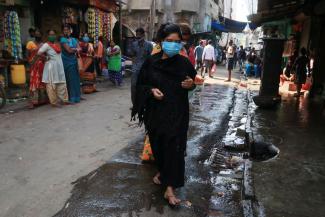Sexual abuse
How some Nepali girls end up as prostitutes
 picture-alliance/NurPhoto/Debajyoti Chakraborty
picture-alliance/NurPhoto/Debajyoti Chakraborty
Nepal is a patriarchal society. Women and girls are considered to be less valuable than men and boys. Many families see daughters as a burden and want to marry them off young. Families who live below the poverty line struggle to make ends meet. Especially in poor rural communities, many people go to bed hungry, at least occasionally. They normally do not hesitate to send their young boys and girls away to work in cities and sometimes even abroad.
Nepal has a history of the Kamalari system. It means that girls from disadvantaged communities are sent to work as domestic servants in more prosperous households of high-caste landowners, business people or civil servants. The Kamalari system has been abolished by law, but it is still in practice to some extent. Traditions are difficult to uproot in low-income countries. The girls are usually aged around eight, but maybe as young as five when they leave their homes.
Obviously, job offers for teenage girls look lucrative to many families, and so do some marriage proposals. Criminal networks exploit vulnerable families. The promise of regular meals, good clothes and a tin roof over the head makes parents send their child away with a complete stranger.
Unknowingly, many parents sell their daughters into sex slavery. Indeed, thousands of women and girls have become prostitutes this way. Very many are being exploited in brothels or private households in India, the Middle East, Southeast Asia and even Africa. Recent reports show that China too seems to be becoming a routine destination for human trafficking from Nepal.
Nepal’s giant neighbouring country, of course, is where women and girls from Nepal are traditionally sent to. Their light skin colour is considered to be very attractive in India. Moreover, there is an irrational belief of sex with Nepali virgins curing various diseases, including HIV/AIDS. As crossing the open border is easy, India has also become a transit country.
A 2018 study conducted by the Indian border guard Sashastra Seema Bal (SSB) stated that 108 girls and children were rescued at the Indo-Nepal border in 2013. By 2017, the number had increased almost six times to 607.
Nepal’s National Human Rights Commission reported in 2019 that “around 35,000 persons in Nepal have been trafficked, whereas around 1.5 million are at risk”. The Commission clarified that both internal and cross-border trafficking were prevalent and that about 15,000 women and 5,000 children had become victims. The true numbers are probably higher as official statistics cannot keep track of undocumented cases.
The background of this terrible trend is extreme poverty, unemployment and poor implementation of Nepal’s anti-trafficking laws. The government of Nepal has indeed imposed restrictions for traveling abroad, given that emigration has become quite common (see box). It has limited the scope for leaving with the intention to become a household helper. The idea is to protect people from possible exploitation.
One consequence, however, is that more women and girls are now leaving the country without proper documents, which makes them even more vulnerable. After all, illegal aliens know they cannot turn to state agencies for help. It is easy to manipulate and control them, so traffickers tend to take passports and other ID documents away if one of their victims happens to possess one.
Once sold to a brothel, victims are trapped. It is very hard for them to move out – and even harder to return home. Shame and stigma matter very much. Moreover, sexual abuse and other forms of physical violence amount to deeply traumatising torture. Victims’ self-confidence tends to be shattered. Many neither believe they can live a normal life anymore – nor that they are entitled to one.
International pattern
There is an international pattern of women from poorer countries being brutally exploited as sex workers in prosperous nations. In the EU, for example, many women workers from the former Soviet Union or Africa are trapped in red-light areas. In the USA, many Latin American women are abused this way.
Things are not entirely hopeless however. Some victims have begun to fight back. Chari Maya Tamang is an example. At the age of 16, she was trafficked from Nepal to an Indian brothel where she was taken advantage of for almost two years. After being freed in a government raid, she returned to Nepal – only to find that her community no longer accepted her. However, she was the first who went to the police and named the people who had trafficked her. In 1997, a law court found eight men guilty.
In cooperation with other trafficking victims, Tamang started a civil-society organisation in 2000. It is called Shakti Shamuna and fights for the rights of trafficked persons. In 2013, it won the prestigious Ramon Magsaysay Award. Another important organisation is Maiti Nepal.
In Nepal it has become common for rescued trafficking victims to file cases against the persons who caused their suffering. The example set by Tamang not only inspires people in Nepal. Activists in many countries around the world are aware of what she suffered and what she has achieved nonetheless.
Rukamanee Maharjan is assistant professor of law at Tribhuvan University, Kathmandu.
rukumaharjan@gmail.com


